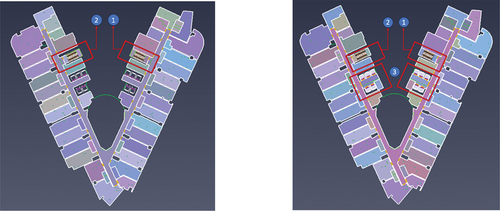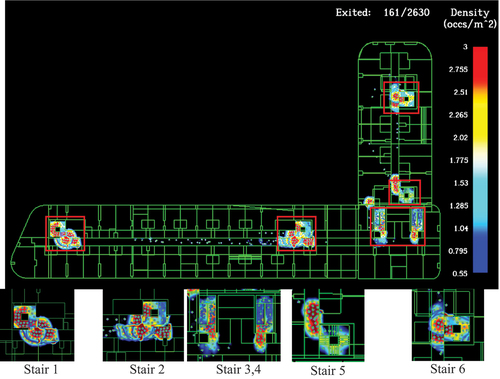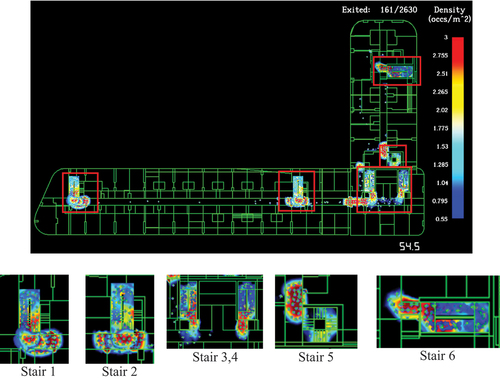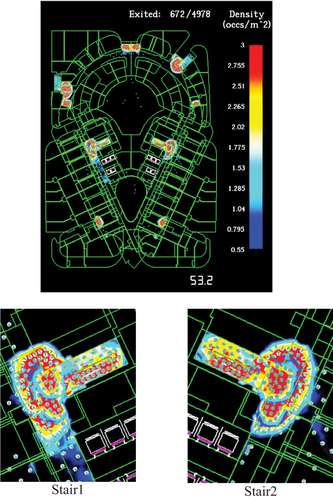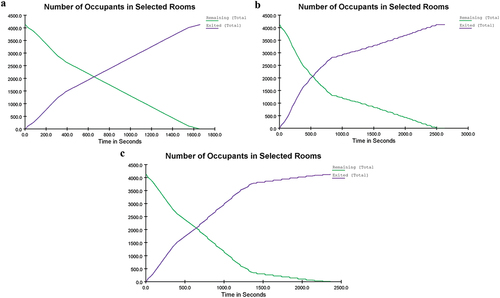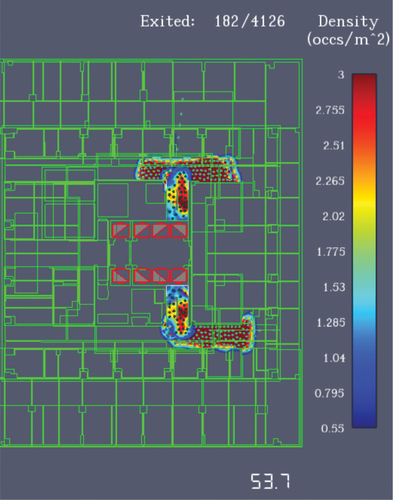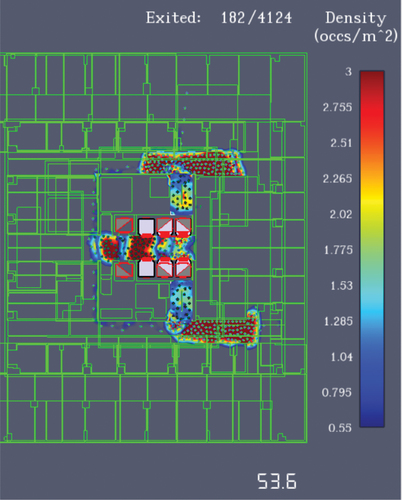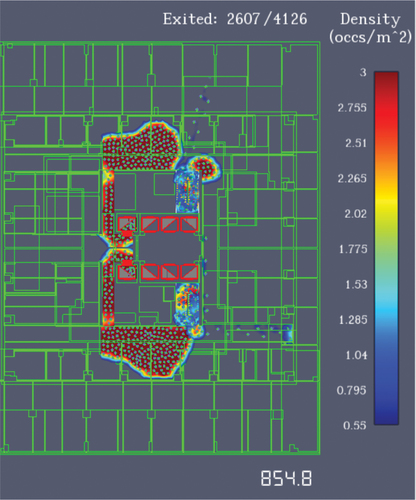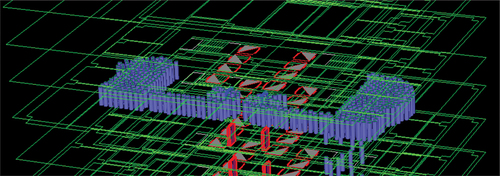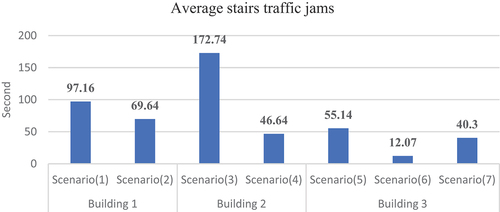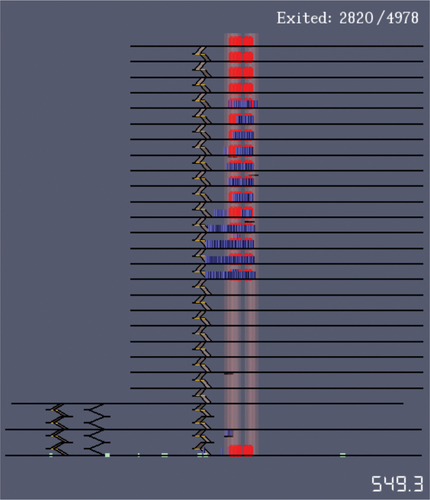ABSTRACT
Recently, the Egyptian government has sought to create new urban spots. The New Administrative Capital was one of those new urban extensions. Architects and urban designers tended to vertical expansion in planning this city as a result of the high cost of the land. Accordingly, high-rise and super-high-rise buildings have been relied upon in the architectural design of the buildings. This study aims to evaluate the achievement of safe occupants’ evacuation in case of fire for two high-rise and one super high-rise complex buildings based on a set of variables. Staircase design, the use of elevators, and the provision of refuge areas were evaluated, through simulating seven scenarios using Pathfinder software. The simulation results comprised an assessment of average stairs traffic jams, the occupant load density on emergency stairs, and the required safe evacuation time (RSET) for each scenario. It was concluded from the study that staircase design has a significant impact on (RSET) time. As well as, evacuation using elevators or relaying on refuge areas as auxiliary means with the emergency stairs may be safer for these types of buildings. Finally, the study provided technical requirements for using refuge areas and elevators in emergency evacuation in high-rise and super high-rise buildings.
Introduction
In modern urbanism, high-rise and super-high-rise complex buildings have become integral parts of cities’ architectural and urban fabric [Citation1]. Nowadays, with the rapid urban development in Egypt, the New Administrative Capital is considered a microcosm of Egypt’s aspiration for achieving comprehensive urban development, where it has undergone significant transformation in buildings form and function, distinguished by the emergence of high-rise and super high-rise complex buildings, which are ambitious megaprojects [Citation2].
In fact, these types of buildings face unique challenges associated with evacuation during emergencies, necessitating comprehensive evacuation strategies [Citation3]. Additionally, multi-purpose high-rise and super-high-rise buildings are different and complex, due to their unique characteristics. These characteristics include the diversity of occupancy during the day, as they are normally used for commercial purposes on the ground and first floors and administrative purposes for the upper floors, generating high population density at specific times of the day [Citation4]. Therefore, the need for efficient evacuation strategies to ensure the safety of all occupants is critical. In other words, these buildings require specific attention and planning to ensure the safety and effective evacuation of occupants during emergencies [Citation5].
Consequently, various evacuation egress components, such as the emergency stairs, refuge areas, and elevators must be studied carefully as comprehensive tools for the evacuation process to preserve the lives of the occupants of the place, taking into account different ages, genders, and the sicks [Citation6]. In this vein, it is be kept in mind that in Egypt, it has been observed in different studies that most cardiovascular diseases nowadays are spread at an early age, were spread especially in young males people than others related to poor dietary habits, smoking, or physical inactivity [Citation7].
correspondingly, most previous studies discussed the evacuation of the high-rise and super-high-rise buildings from one perspective, where it focused on assessing one building with a specific height and choosing one of the variables that affect the evacuation process, such as stairs, and evaluating the extent to which they achieve a safe evacuation or not [Citation8]. Therefore, the results and conclusions of these studies presented an incomplete vision of the evacuation process for these types of buildings. To address this gap, this study aims to present a holistic approach, considering several variables at the same time, such as the height of the buildings, evacuation scenarios, and the egress components, to form a comprehensive vision that enables designers to provide evacuation models in accordance with the variables of each building to achieve the safest evacuation process. This contribution is based on Pathfinder as a simulation tool, that is used to evaluate the evacuation time for three under construction buildings through seven scenarios for occupants’ evacuation, considering specific constraints.
Literature review
In this section, the study highlighted the classification of high-rise and super-high-rise buildings. In addition, the egress components of these buildings and their importance were explained, especially the elevators and refuge areas, which plays an important role in the evacuation process. Furthermore, emergency evacuation scenarios and their strategies were discussed. Then, the study focused on the importance of using computer simulation in evaluating the evacuation process for these buildings. A review of the Pathfinder software was presented as an analysis chosen tool.
High-rise/super-high-rise buildings: definition and classification
The global proliferation of high-rise buildings is a response to limited land availability and their pivotal role in modern cities. However, their intricate nature and safety considerations, such as robust fire safety systems and advanced structural design, present unique challenges compared to low-rise structures [Citation9]. The classification of high-rise and super high-rise buildings is primarily based on their height and number of floors, with definitions and classifications varying across regions and organizations as illustrated in ().
Table 1. High-rise/super high-rise building classification.
In this context, a high-rise building can be explained as a structure with a minimum average height of up to 125 meters, and every building above will be categorized as super high rise and ultra-high-rise building. Ultimately, these classifications may be increased/decreased based on the countries’ regulations, and rapidly urbanism changing [Citation17].
High-rise/super-high-rise buildings: emergency evacuation scenarios
Evacuation scenarios are crucial for ensuring the safety of building occupants during fires, especially in super high-rise buildings [Citation18]. Accordingly, various scenarios have been developed and tested worldwide to optimize evacuation processes using egress components to reduce evacuation times, and ensure the safety of occupants during fires [Citation19]. These scenarios can be summarized as demonstrated in ().
Table 2. Description of emergency evacuation scenarios.
Adequately, understanding these evacuation scenarios and strategies above, the evacuation process in high-rise and super-high-rise buildings can be enhanced, thus prioritizing the safety and security of their occupants.
Egress components in high-rise/super-high-rise buildings
Evacuations in high-rise buildings are different from those in other buildings due to the significant vertical distances that are going up day by day [Citation25]. Therefore, using emergency stairs only could not achieve a safe evacuation, especially for the elderly, those with disabilities, and people with health issues [Citation26]. Consequently, it must be considered to implement other egress components represented in refuge areas and elevators to ensure smooth and efficient evacuation procedures [Citation27]. Notably, in 2011, the Council for Tall Buildings and Urban Habitats (CTBUH) published research with the intention of fostering a better understanding of the concepts of evacuation. Also, attention has been drawn to the need for design solutions to evacuate occupants in high-rise buildings, particularly in the provision of refuge areas [Citation28].
Refuge area: definition and importance
A refuge area is a designated safe space as a temporary shelter, providing a secure haven during emergencies for occupants who are completely or partially unable to use emergency stairs [Citation29]. The crucial roles of the refuge area are to serve occupants with disabilities and young children awaiting rescue by fire authorities, or briefly rest before continuing their escape [Citation30]. Previous studies and international codes have shown that the refuge area must accommodate the anticipated number of occupants during an emergency without overcrowding. Therefore, the refuge should accommodate at least 25% of the total gross floor occupancy load [Citation31]. Continuously, various building codes and standards determined the refuge floor location, as illustrated in (). It is noteworthy, that most of the codes determined refuge floor location applied at 24 stories or more [Citation32]. As a result of the large number of occupants gathering on a refuge floor, there are several issues to consider for their comfort and safety: including provisions for toilets and drinking water, seating or standing accommodations, emergency power, protection from fire effects, and reliable ventilation/HVAC design [Citation33]. Additionally, evacuation drills for refuge area play a crucial role in avoiding crowd management issues, where Human behavior, influenced by factors such as crowding, uncertainty, increased heat, and physical discomfort, can elevate stress levels and impatience during an evacuation [Citation34].
Table 3. Comparison of refuge floor location among countries.
Elevators
Elevators are being utilized widely in high-rise buildings and becoming a very important traffic element due to their efficient operation and fast running [Citation35]. Therefore, in foreign countries, researchers have been studying elevator evacuation in high-rise building fires since the mid-20th century, especially following the collapse of the World Trade Center on 11 September 2001, which led to widespread recognition of the use of elevators for evacuation during high-rise building fires [Citation36]. That led to a growing interest in the potential value of using elevators as an evacuation component in high-rise buildings [Citation37]. John H. Klote and others introduced the concept of Emergency Elevate Evacuation Systems (EEES) in 1994 and explored the feasibility of elevator evacuation.
In fact, one of the common methods of using elevators in emergency evacuation is sectorization, where the building is divided into zones and each zone is serviced by specific elevators, which leads to increasing capacity and reducing waiting times [Citation38]. However, ensuring the security of elevator evacuation during fires and taking advantage of elevators as a vertical transportation to evacuate more people in the shortest time requires maintaining a set of scientific conditions, such as protecting the elevator system from heat, smoke, water, and loss of power considering the total evacuation time to be reduced [Citation39].
Simulating fire emergency evacuation with pathfinder
The construction codes provide minimum safety requirements for high-rise buildings. However, additional measures are needed to enhance fire safety. Computer simulation algorithms (software) have proven effective in understanding high-rise building evacuations during fire emergencies, as demonstrated in various studies [Citation40]. These algorithms accurately model and predict evacuation dynamics, facilitating the optimization of evacuation strategies, and ensuring the safety of lives and property [Citation41].
Pathfinder is considered one of the famous tools that is widely recognized and utilized in this field [Citation42]. In this regard, the simulations conducted using the Pathfinder software consider variables such as the number of elevators, stairs, and refuge floors, to determine the number of people remaining in the building within a specified time frame [Citation43]. Simultaneously, the software also calculates travel distance, density, and evacuation time, taking into account factors such as age, gender distribution ratios, and optimizing the use of exits [Citation44]. Consequently, this study adopted Pathfinder simulation software as an analytical comprehensive tool to provide valuable insights into evacuation, understand evacuation dynamics, and optimize safety measures during emergencies in three high-rise buildings (the case studies) by using software Steering Mode. In fact, this mode employs steering mechanisms and collision handling to control occupant movement, allowing for deviations from the path while still progressing toward the intended goal.
Materials and methods
Due to the nature of high-rise buildings, especially multi-use complexes, the high occupancy load on the lower floors (ground and the typical two floors above), which are normally used as commercial centers (malls and megastores), and the high gross occupancy load on the business floors. In this context, the study sought to assess and verify the achievement of safe occupants’ evacuation in case of fire by performing a simulation using Pathfinder tool for three buildings with different scenarios. This study methodology has four sections as illustrated in ().
Case studies: the selection of the buildings
Currently, many high-rise buildings in the new capital are under construction. Theoretically, the height of the buildings is one of the main factors that influences the evacuation time. Hence, three buildings with different heights were chosen to evaluate evacuation time based on a set of variables. In this regard, these variables were staircase design, the use of elevators, and the provision of refuge areas. Notably, all of these buildings are classified as multi-use complex buildings, which consist of commercial use on the lower floors, and business use on typical floors. The heights of the buildings are in order 49.25 m (15 floor), 95 m (24 floor), and 160 m (41 floor). The buildings’ specifications including floors area, number of floors, and number of emergency staircases are illustrated in ().
Table 4. Description of the buildings.
Validation of the case studies
In this step, the selected three buildings were examined to ensure the extent to which these buildings fulfilled the architectural requirements of the Egyptian code for protecting buildings from fire, and the international codes and standards that were mentioned in the literature review. In this respect, the travel distance, dead end, number of exits, number of emergency stairs, and emergency stairs width were evaluated. Notably, this step is considered critical to ensuring the accuracy of simulation results. Therefore, by analyzing the ground and typical plans for the three buildings, and comparing them to the architectural requirements of the code as illustrated in detail in (), it was found that they covered these requirements. Hence, the three cases are valid for the simulation process.
Table 5. The architectural requirements of the Egyptian code for protecting buildings from fire and international codes.
Simulation
In this study, Pathfinder version 2019.2 was used to evaluate the evacuation process for the mentioned buildings above. In fact, there are many factors that affect the evacuation simulation. Therefore, thirteen constraints and determinants were imposed and applied in all (cases/scenarios) as shown in (). Additionally, the occupants are randomly placed in the rooms, the simulation type will be based on the steering mode, and the simulation will run immediately after the occupants start to evacuate.
Table 6. The constraints and determinants of the study.
Meanwhile, the study assumed seven scenarios based on different variables that applied in the three cases, where:
a- The first building (C1), the total number of occupants was reached 2630 person, and the occupant load on the typical floor was 176 persons.
Two scenarios were assumed as:
Scenario (1): the simulation was carried out based on the current type and location of emergency stairs provided by the designer.
Scenario (2): the type of the staircases’ forms (No:1, No:2, and No:6) were changed to two flights and one landing instead of four flights and three landings as presented in ().
b- In the second building (C2), the total number of occupants was reached 4978 persons, and the occupant load on the typical floor was 144 persons.
Two scenarios were assumed as:
Scenario (3): the evacuation simulation process was implemented relying on the emergency stairs in the building only.
Scenario (4): the evacuation assumption in this scenario relied on emergency stairs only up to level (+42.6, the 12th floor). Then, 10 elevators located on the typical floors’ wings with 12-person capacity for each were added to the simulation to evacuate the occupants in the upper floors as illustrated in ().
c- In the third building (C3), the total number of occupants was reached 4126 persons, and the occupant load per typical floor was 72 persons.
Three scenarios were assumed as:
Scenario (5): the evacuation simulation process was implemented relying on the emergency stairs in the building only.
Scenario (6): the evacuation assumption in this scenario relied on emergency stairs only up to level (+42.6, the 12th floor). On the upper floors, 25% of the occupancy load used six elevators with 12-person capacity for each in the evacuation process, without using the firefighting elevators.
Scenario (7): the evacuation assumption in this scenario relied on emergency stairs only up to level (+42.6, the 12th floor). On the upper floors, 25% of the occupant load went downstairs to two refuge areas on level (+91.8, the 24th floor). Then, they used the two firefighting elevators in the evacuation process as shown in ().
Calculating the required safe evacuation time (RSET)
The required safe evacuation time (RSET) is the time needed to keep the occupants out of the building and remaining in a safe zone. In other words, (RSET) refers to the time required to evacuate all onsite persons from the building to a safe place once the emergency is discovered and the alarm system is triggered. (RSET) calculated as follows:
RSET = Alarm time (Talarm) + Response time (Tpre) + Evacuation time (Tmov)
Where:
Alarm time (Talarm) = the time between the fire occurring and the alarm triggering.
Response time (Tpre) = the response time of the occupants after receiving evacuation instructions.
Evacuation time (Tmov) = the time for a full evacuation. It can be deduced from the simulation.
Whereas advanced alarm and monitoring systems are considered in high-rise buildings, the alarm and response time will be relatively short. Therefore, (Talarm), and (Tpre) are set to 60s in this study. Additionally, the evacuation time (Tmov) cannot be considered the simulation result only, because it depends on the occupants’ physical attributes, psychological changes, and a host of other factors that are difficult to measure. Consequently, the simulation result must be multiplied by a coefficient of (1.5 to 2) in addition. In this study, the coefficient of 1.5 was adopted.
Correspondingly, (RSET) must be compared with the available safe evacuation time (ASET), where (ASET) refers to the time between the ignition of the fire and the time that the safety factors were exceeded as a result of heat, smoke, and toxic effluents. Therefore, the occupants cannot afford to stay. Regarding NFPA101 recommendations, the acceptable (ASET) for high-rise buildings can be up to two hours. Understandably, the purpose of this step is to ensure that the (RSET) is less than (ASET).
Results
Regarding the simulation results models from Pathfinder for the three buildings with seven scenarios based on the constraints and determinants of the study, and the assumed variables in each scenario. The total occupant load for each building was calculated according to the distribution of occupant load factors (density-m2/person)) related to the commercial and business floors areas/spaces. And the evacuation times during the emergency were deduced. In this context, the results are summarized based on the Pathfinder output as follows:
Simulation result of building 1 (C1)
In Scenario (1): The total number of occupants was 2630 person. The total occupants on the commercial floors were 574 persons, and the total occupants on the business floors were 2056 persons. Additionally, the evacuation time for the commercial floors was 140s, and the total evacuation time of the building was 995s as shown in (). The first occupant’s exit time was 10.95s, and the maximum travel distance (last) was 296.81 m.
In Scenario (2): The total evacuation time of the building was 760s as shown in (). The maximum travel distance (last) was 261.3 m. More specifically, the total evacuation times, and the occupants’ behavior for the two scenarios are illustrated in detail in ().
Table 7. The occupants’ behavior for scenario 1, and 2.
As can be seen in (), a high density of occupants was observed on the staircases (No:1, No:2, and No:6) in scenario 1, where it was recorded an average of 2.8, 2.4, and 2.00 (occs/m2) in order. On contrast, in scenario 2, a normal density of occupants was achieved an average of 1.04 for all stairs except stair no:5, it was recorded 2.02 (occs/m2) as illustrated in (). As regards the (RSET) calculations, the (RSET) was obtained 1612.5s for scenario 1, and 1260s for scenario 2.
Simulation result of building2 (C2)
In Scenario (3): The total number of occupants was 4978 persons. The total occupants on the commercial floors were 1729 persons, and the total occupants on the business floors were 3249 persons. Additionally, the evacuation time for the commercial floors was 259s, and the total evacuation time of the building was 1908.6s as shown in (). The first occupant’s exit time was 3.9s, and the maximum travel distance (last) was 544.42 m.
In Scenario (4): The total evacuation time of the building was 2152s as shown in (). The maximum travel distance (last) was 395.2 m. Notably, 1551 occupants used the elevators in the evacuation process in this scenario. More specifically, the total evacuation times, and the occupants’ behavior for scenarios 3, and 4 are illustrated in detail in ().
Table 8. The occupants’ behavior for the for scenario (3), and (4).
It was noted in (), that a high density of occupants was observed on the staircases (No:1, and No:2) in scenario 3, where it was recorded an average of 2.75 (occs/m2). On contrast, in scenario (4), a normal density of occupants was achieved an average of 0.75 (occs/m2) for all stairs as illustrated in (). As regards the (RSET) calculations, the (RSET) was obtained 2982.9s for scenario (3), and 3348s for scenario (4).
Simulation result of building 3 (C3)
In Scenario (5): The total number of occupants was 4126 persons. The total occupants on the commercial floors were 1292 persons, and the total occupants on the business floors were 2834 persons. Additionally, the evacuation time for the commercial floors was 318s, and the total evacuation time of the building was 1658s as shown in (). The first occupant’s exit time was 2.45s, and the maximum travel distance (last) was 645.42 m.
In Scenario (6): The total evacuation time of the building was 2624.28s as shown in (). The maximum travel distance (last) was 582.98 m. meanwhile, 648 occupants used the elevators in the evacuation process in this scenario.
In Scenario (7): The total evacuation time of the building was 2358.75s as shown in (). The maximum travel distance (last) was 635.98 m. In this respect, 648 occupants went downstairs to two refuge area on level (+91.8, the 24th floor). Then, they used the two firefighting elevators in the evacuation process as shown in (). More specifically, the total evacuation times, and the occupants’ behavior for scenarios (5), (6), and (7) are illustrated in detail in ().
Table 9. The occupants’ behavior for scenario (5), (6), and (7).
Respectively, in () a high density of occupants was observed on the staircases (No:1, and No:2) in scenario 5, where it was recorded an average of 2.7 (occs/m2), and 2.5 (occs/m2) in order. In contrast, in scenario 6, a normal density of occupants was achieved an average of 1.28 for all stairs as shown in (). Additionally, in () a high density of occupants was observed in the refuge areas in scenario 7, where it was recorded an average of 3 (occs/m2). As regards the (RSET) calculations, the (RSET) was obtained 2607s for scenario (5), 3906.42s for scenario (6), and 3658.13s for scenario (7).
Discussion
It can be seen from the simulation results that the required safe evacuation time (RSET) for the seven scenarios was less than 2 hours. Therefore, the evacuation process is considered acceptable for all scenarios as shown in (). More specifically, in building (1), the change of the staircases’ forms (No:1, No:2, and No:6) to two flights and one landing instead of four flights and three landings had a significant impact on the evacuation process, where 21.8% of the evacuation time was reduced. Additionally, the average stairs traffic jams were reduced by 28.3% as illustrated in (). In this context, although scenario (1), and scenario (2) were achieved acceptable (RSET) theoretically. The second scenario is safer in the evacuation process, as the lower average density on the stairs plays a critical role in reducing the probability of accidents and panic resulting from people crowding in the emergency case.
As regards building (2) scenarios (3), and (4), the use of the elevators in scenario (4) reduced the average stairs traffic jams by 73%, which was also reflected in the density of occupants on the staircases (No:1, and No:2) where, a normal density of occupants was observed with an average of 0.75 for all stairs as illustrated in () above. Correspondently, the evacuation time in scenario (4) was slightly increased by 10.9% as seen in (). This increase was due to the elevators’ behavior, which needs 6.0s for opening and closing per trip. Adequately, it is clear from () in the simulation of scenario (4) that 56.6% of the occupants were evacuated by stairs within 549.3s, which represents 25.5% of the (Tmov). In fact, that explains how the opening and closing time of the elevators affects the total evacuation time.
In building (3), scenario (6) achieved the highest (RSET), and the minimum traffic jams on the stairs with an average of 12.07s. That ensures how the use of the elevators in the evacuation process has a significant impact on reducing the density in the emergency stairs. Continuously, the use of the refuge area on level (+91.8, the 24th floor) in scenario (7) reduced the average stairs traffic jams by 26.9% from scenario (5).
It is worth noting that the evacuation time of the commercial floors (ground, first, and second) of the three buildings recorded an average evacuation time that didn’t exceed 14.7% of the total evacuation time of the buildings, which means that the evacuation of those floors doesn’t represent any problem or threat to the evacuation process in this type of buildings, as shown in ().
Table 10. The (Tmove) for the commercial floors in the three buildings.
Meanwhile, the time of evacuation using emergency stairs was the shortest in the seven scenarios, where, it was recorded at 1260s, 2982.9s, and 2607s, respectively. However, when taking into account the average stairs traffic jams on those stairs, it was found that they were the highest among all scenarios. Therefore, these scenarios are not the safest in the evacuation process due to the high probability of increasing casualties among the occupants while escaping as a result of crowding, especially those over 50 years old.
From this point of view, evacuation using elevators or relaying on refuge areas as auxiliary means with the emergency stairs may be safer for these types of buildings, especially as a result of the high occupancy loads therein. Consequently, a set of technical requirements, whether architectural or mechanical must be achieved in elevators and refuge areas to ensure a safe evacuation. These requirements can be explained and summarized in (), and () as follows:
Table 11. The requirements for refuge areas.
Table 12. The requirements for the elevators.
It is noteworthy, to achieve a smart evacuation by using elevators, it must be incorporated Emergency Dispatching System (EEDS) for prioritizing the fire floor or dispatching elevators from top to bottom, to improve the efficacy of elevator-aided evacuation (EAE) [Citation52]. Accordingly, this solution can provide a dynamic planning and optimization framework for efficient evacuation strategies utilizing smart elevators, ensuring both safety and effectiveness during building fire emergencies [Citation53].
Conclusion
gEmergency evacuation in high-rise and super-high-rise buildings is a complex and challenging process. Notably, most of these buildings are multi-use, as commercial on the ground and first floors, and business on the upper floors. Simulation tools can potentially test and evaluate alternative scenarios to ensure the safety of evacuation procedures. This study highlighted the emergency evacuation scenarios and the evacuation egress components in these types of buildings. The pathfinder as a simulation tool was applied to analyze the evacuation process for two high-rise buildings, and one super-high-rise building through simulating seven scenarios. The simulation result for building 1 (scenario 1, and 2) illustrated that the change of the staircases’ forms to two flights and one landing instead of four flights and three landings was reduced by the (RSET) by 21.8%. This finding reflected that staircase design had a significant impact on the evacuation process. Respectively, for building 2 (scenario 3 and 4) the results showed that the use of the elevators in scenario (4) reduced the average stairs traffic jams by 73%, where normal density of occupants was observed with an average of 0.75 for all stairs, but the evacuation time was slightly increased by 10.9%. Likewise, building 3 (scenarios 5, 6, and 7) results indicated that scenario (6) achieved the highest (RSET), and the minimum traffic jams on the stairs with an average of 12.07s. Continuously, the use of the refuge area in scenario (7) reduced the average stairs traffic jams by 26.9% from scenario (5). Through the results of (scenarios 4, 6, and 7), it was clear how the use of the elevators and refuge area in the evacuation process has a significant impact on reducing the density of the emergency stairs, therefore deducing the probability of accidents and panic resulting from people crowding on stairs in emergency case. Sufficiently, further studies are required to address emerging challenges in this field. Hence, we can work toward improving high-rise and super-high-rise buildings’ safety to reduce the risk of loss of life and property in emergency situations.
Disclosure statement
No potential conflict of interest was reported by the author(s).
Additional information
Funding
References
- Yang F. High-rise urban form and environmental performance - an overview on integrated approaches to urban design for a sustainable high-rise urban future. Int J High-Rise Build. 2016;5(2):87–94. doi: 10.21022/ijhrb.2016.5.2.87
- Korrat IM, Lethy A, ElGabry MN, et al. Discrimination between small earthquakes and quarry blasts in Egypt using spectral source characteristics. Pure Appl Geophys. 2022;179(2):599–618. doi: 10.1007/s00024-022-02953-w
- Şahin C, Rokne J, Alhajj R. Human behavior modeling for simulating evacuation of buildings during emergencies. Phys A Stat Mech Appli. 2019;528:121432. doi: 10.1016/j.physa.2019.121432
- Generalova E, Generalov V. Connecting a skyscraper to urban space: a stylobates typology for tall buildings. In: IOP conference series: materials science and engineering. Vol. 1079, No. 2: IOP Publishing; 2021 March; p. 022034. doi: 10.1088/1757-899X/1079/2/022034
- Butler K, Kuligowski E, Furman S, et al. Perspectives of occupants with mobility impairments on evacuation methods for use during fire emergencies. Fire Saf J. 2017;91:955–963. doi: 10.1016/j.firesaf.2017.04.025
- Ding N, Zhang H, Chen T. Experimental study of egress selection behavior between stairs and elevators during high-rise building evacuation. Fire Technol. 2019;55(5):1649–1670. doi: 10.1007/s10694-019-00822-y
- Farrag A, Eraky A, Aroussy W, et al. Obesity and other cardiovascular risk factors in Egyptian university students: magnitude of the problem. Epidemiol. 2015;5(181):2161–1165. doi: 10.4172/2161-1165.1000181
- Mossberg A, Nilsson D, Andrée K. Unannounced evacuation experiment in a high-rise hotel building with evacuation elevators: a study of evacuation behaviour using eye-tracking. Fire Technol. 2020;57(3):1259–1281. doi: 10.1007/s10694-020-01046-1
- Hassanain MA. On the challenges of evacuation and rescue operations in high‐rise buildings. Structural Survey. 2009;27(2):109–118. doi: 10.1108/02630800910956443
- Al-Kodmany K. Sustainability and the 21st century vertical city: a review of design approaches of tall buildings. Buildings. 2018;8(8):102. doi: 10.3390/buildings8080102
- Tracy J, Murphy J, Murtagh J. High-rise buildings: understanding the vertical challenges. Tulsa, Oklahoma, USA: Fire Engineering Books; 2023.
- Ballo Y, Yakovchuk R, Kovalchuk V, et al. Investigation of the fire-preventing eaves effectiveness to prevent the fire spreading by vertical building structures of high-rise buildings. AIP Conference Proceedings; 2023. doi: 10.1063/5.0119998
- Ching FD, Winkel SR. Building codes illustrated: the basics. USA: John Wiley & Sons; 2022.
- Yang Y. High-rise building structure. Tech Code For Monitor Build Struct. 2019;25–29. doi: 10.1007/978-981-15-1049-6_6
- Ilgın HE. High-rise residential timber buildings: emerging architectural and structural design trends. Buildings. 2023;14(1):25. doi: 10.3390/buildings14010025
- Li J, Zheng B, Bedra KB, et al. Effects of residential building height, density, and floor area ratios on indoor thermal environment in Singapore. J Environ Manage. 2022;313:114976. doi: 10.1016/j.jenvman.2022.114976
- Cheng H. Exploration of structural design principle and construction technology application for super high-rise buildings. Highlights Sci, Engg Technol. 2023;51:57–62. doi: 10.54097/hset.v51i.8238
- Taleai M, Mokhtari M, Zlatanova S. 3d based smoke fire emission and emergency evacuation simulation in high-rise buildings. The Internat Arch Photogrammetry, Remote Sens Spat Informat Sci. 2022;XLVIII-4/W4-2022:139–146. doi: 10.5194/isprs-archives-xlviii-4-w4-2022-139-2022
- Sun Q, Turkan Y. A BIM-based simulation framework for fire safety management and investigation of the critical factors affecting human evacuation performance. Advan Eng Inform. 2020;44:101093. doi: 10.1016/j.aei.2020.101093
- Bilintoh NM, Zhang J, Karim R, et al. Analyzing emergency evacuation scenarios in Ghana based on different groups profiles in a classroom. Cogent Eng. 2023;10(1). doi: 10.1080/23311916.2023.2191882
- Rismanian M, Zarghami E. Evaluation of crowd evacuation in high-rise residential buildings with mixed-ability population: combining an architectural solution with management strategies. Int J Disaster Risk Reduct. 2022;77:103068. doi: 10.1016/j.ijdrr.2022.103068
- Wajdi Akashah F, Kurannen Baaki T, Anuar MF, et al. Factors affecting adoption of emergency evacuation strategies in high-rise office buildings. J Design Built Environ. 2020;20(3):1–21. doi: 10.22452/jdbe.vol20no3.1
- Park S, Mizuno M, Fujii K, et al. Improvement of phased evacuation scenario based on analyses of pedestrian flow in stairwell during drills in high-rise office building. J Life Support Engg. 2020;32(4):118–125. doi: 10.5136/lifesupport.32.118
- Chu H, Yu J, Wen J, et al. Evacuation simulation and emergency management optimization in urban residential communities. IOP Conf Series: Earth And Environ Sci. 2019;234:012040. doi: 10.1088/1755-1315/234/1/012040
- Chung K, Park C, Kim D. Design considerations for concrete high-rise buildings. Internat J High-Rise Build. 2016;5(3):187–193. doi: 10.21022/ijhrb.2016.5.3.187
- Hostetter H, Naser M. Characterizing disability in fire evacuation: a progressive review. J Buil Eng. 2022;53:104573. doi: 10.1016/j.jobe.2022.104573
- Park H, Lee Y. Study on the shortening effect of the egress travel time based on an escape scenarios by using shuttle elevators for lotte tall building’s evacuation plan. Fire Sci Eng. 2018;32(6):46–54. doi: 10.7731/kifse.2018.32.6.046
- Ronchi E, Nilsson D. Fire evacuation in high-rise buildings: a review of human behaviour and modelling research. Fire Sci Rev. 2013;2(1):7–21. doi: 10.1186/2193-0414-2-7
- Minegishi Y, Matsuda D, Shinozuka R, et al. Planning of intermediate refuge floors as a comprehensive measure for business continuity planning of after large earthquakes and mitigation of fire damage on super high-rise buildings. The Proceedings of 11th Asia-Oceania Symposium on Fire Science and Technology; 2020. p. 831–844. doi: 10.1007/978-981-32-9139-3_61
- Lena K, Kristin A, Staffan B, et al. How do people with disabilities consider fire safety and evacuation possibilities in historical buildings? —A Swedish case study. Fire Technol. 2012;48(1):27–41. doi: 10.1007/s10694-010-0199-0
- McGann S, Creagh R, Tye M, et al. Stairway to health: an analysis for workplace stairs design and use. In Living and learning: research for a better built: Proceedings of the 49th International Conference of the Architectural Science Association; 2015. https://www.researchgate.net/publication/286920617
- Hutomo CS, Tambunan L. Study of TODs tall building fire evacuation: refuge floor utilities. In: IOP conference series: earth and environmental science. Vol. 532, No. 1: IOP Publishing; 2020 July; p. 012022. doi: 10.1088/1755-1315/532/1/012022
- Cheng CCK, Leung AYT, Lam KM, et al. A CFD study of Hong Kong refuge floor design: floor height effect. Eng Appl Comput Fluid Mech. 2010;4(3):425–433. doi: 10.1080/19942060.2010.11015329
- Cheng H, Zhuang Y, Luo L, et al. Effect of the starting time delay on the confluence pattern during staircase evacuation of a multi-story building. Adv Intell Syst Comput. 2018;315–327. doi: 10.1007/978-3-319-94589-7_31
- Dmitriev I, Kuzenkov K, Kankhva V, et al. The use of elevators in the evacuation of high-rise buildings. MATEC Web Conf. 2018;193:03030. doi: 10.1051/matecconf/201819303030
- Hu Y, Liu X. Optimization of grouping evacuation strategy in high-rise building fires based on graph theory and computational experiments. IEEE/CAA J Automatica Sinica. 2018;5(6):1104–1112. doi: 10.1109/jas.2018.7511231
- Minegishi Y. Occupant evacuation elevators as a measure for crowd management and evacuation for people with mobility impairments in high‐rise buildings. Japan Architect Rev. 2021;4(2):391–402. doi: 10.1002/2475-8876.12219
- Khalid Q, Lujak M, Fernández A, et al. On the use of elevators during emergency evacuation. Adv Intell Syst Comput. 2019;149–156. doi: 10.1007/978-3-319-99608-0_17
- Sale MD, Chandra Prakash V. Dynamic scheduling of elevators with reduced waiting time of passengers in elevator group control system: fuzzy system approach. Innovat Comput Sci Engg. 2017;339–345. doi: 10.1007/978-981-10-3818-1_37
- Zhou M, Zhou B, Zhang Z, et al. Fire egress system optimization of high-rise teaching building based on simulation and machine learning. Fire. 2023;6(5):190. doi: 10.3390/fire6050190
- Wang Y, Ma W, Wang T, et al. Dynamic optimisation of evacuation route in the fire scenarios of offshore drilling platforms. Ocean Eng. 2022;247:110564. doi: 10.1016/j.oceaneng.2022.110564
- Zang Y, Mei Q, Liu S. Evacuation simulation of a high-rise teaching building considering the influence of obstacles. Simul Modell Pract Theory. 2021;112:102354. doi: 10.1016/j.simpat.2021.102354
- Soltanzadeh A, Alaghmandan M, Soltanzadeh H. Performance evaluation of refuge floors in combination with egress components in high-rise buildings. J Buil Eng. 2018;19:519–529. doi: 10.1016/j.jobe.2018.05.029
- Hu J, Wu H, Chou C. Evacuation simulation in a cultural asset fire: impact of fire emergency evacuation facilities for people with disabilities on evacuation time. Fire. 2022;6(1):10. doi: 10.3390/fire6010010
- Kinateder MT, Omori H, Kuligowski ED. The use of elevators for evacuation in fire emergencies in international buildings. US Department of Commerce, National Institute of Standards and Technology; 2014. p. 1–29. doi: 10.6028/NIST.TN.1825
- Kariyawasam H, Withanage D, Konara H, et al. Analysis of natural ventilation of refuge floor in high rise buildings. 2023. arXiv preprint arXiv:2306.10145. doi: 10.48550/arXiv.2306.10145
- Ronchi E, Nilsson D. Modelling total evacuation strategies for high-rise buildings. In: Building simulationVol. 7. Berlin Heidelberg: Springer; 2014 February. p. 73–87. doi: 10.1007/s12273-013-0132-9
- Shangguan C, Xu J, Wei H, et al. Study on multi-effect design of shaft for preventing the piston effect of fire elevator in super high-rise building. 2021 3rd International Conference on Artificial Intelligence and Advanced Manufacture; 2021. doi: 10.1145/3495018.3495300
- Yang Y, Hou R, Xie C. Full-scale experimental simulation of the stack effect pressure acting on an elevator door system in a high-rise building. 2023. doi: 10.2139/ssrn.4643899
- Song D, Lim H, Lee J, et al. Application of the mechanical ventilation in elevator shaft space to mitigate stack effect under operation stage in high-rise buildings. Indoor Built Environ. 2014;23(1):81–91. doi: 10.1177/1420326X13480055
- Lv X, Zou T, Zhang X, et al. Research on novel power supply mode for elevators based on inductively coupled power transfer technology. 2020 5th International Conference on Smart Grid and Electrical Automation (ICSGEA); 2020. doi: 10.1109/icsgea51094.2020.00015
- Chen Y, Wang C, Yap JB, et al. Fire evacuation process using both elevators and staircases for aging people: simulation case study on personnel distribution in high-rise nursing home. Discrete Dyn Nat Soc. 2020;2020:1–14. doi: 10.1155/2020/5365126
- Fang H, Qiu H, Lin P, et al. Towards a smart elevator-aided fire evacuation scheme in high-rise apartment buildings for elderly. IEEE Access. 2022;10:90690–90705. doi: 10.1109/ACCESS.2022.3201516



